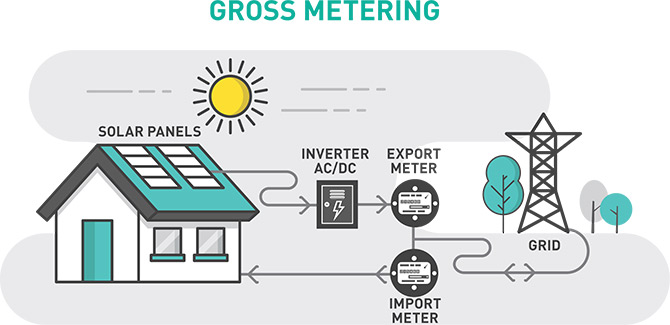Let’s say you have a rooftop solar system. It generates 10 units (kWh) of electricity during the day, but you only consume 8 units for powering your various devices/appliances. You are left with 2 excess units. What do you do with them? You can either let them go waste, store them for future use (using a battery backup system), or feed them into the grid.
At night, without the sun powering your rooftop system, you again need electricity. You can either get that from your battery backup system (if you have one), or from the central grid, or from both of them combined. Let’s say you fed the 2 excess units during the daytime into the grid and then consumed 2 units from the grid at night. Your day’s grid electricity balance would have been 0.

Net metering as shown above allows you to do that. It adjusts what you feed into the grid against what you take from the grid and only charges your for the difference. Nice, isn’t it? In some cases, if you supply more power to the grid than you draw from it, you can even earn money this way.

Net Metering vs. Gross Metering
In another case, let’s say that you choose to feed in all of the electricity that your rooftop solar system generates (10 units in this example) directly into the central grid without consuming any of it at your house. Instead, both at night and the day, you consume electricity from the grid. At the end of the day, you will have had a cumulative electricity consumption from the grid, as well as having fed electricity into the grid. You will be billed for your cumulative consumption, AND you will be paid for the “gross amount of electricity” you pumped into the grid. These are two entirely separate billing processes. This payment mechanism is called gross metering.
Therefore the essential difference between net metering and gross metering is that under the former, you are billed only for your “net electricity consumption”, while under the latter, you are paid for the “gross amount” of electricity you feed into the grid, while being charged in full for your grid electricity consumption.
Feed-in Tariffs
Another commonly used term is that of feed-in tariffs (FiT). FiT is essentially a tariff that is paid to the power developer for generating and selling electricity. This was used a lot in the past, when solar was still very expensive – more expensive than the grid tariffs. The government needed to give solar producers an extra incentive to go solar.
For example, at many utility scale solar power plants, all of the electricity produced (except for a small percentage required to power operations) is fed into the central grid at a rate that is pre-agreed upon by the seller (power plant developer) and the buyer (state utility).
For distributed users like households or industries, are today far less in use. Solar is now much cheaper and competitive with end user tariffs (this is called “socket parity”).

Leave A Comment